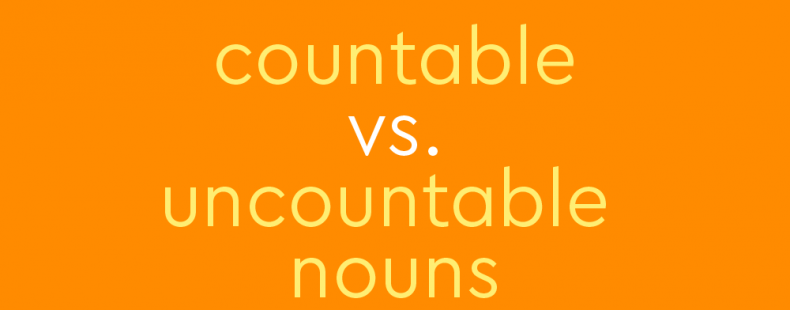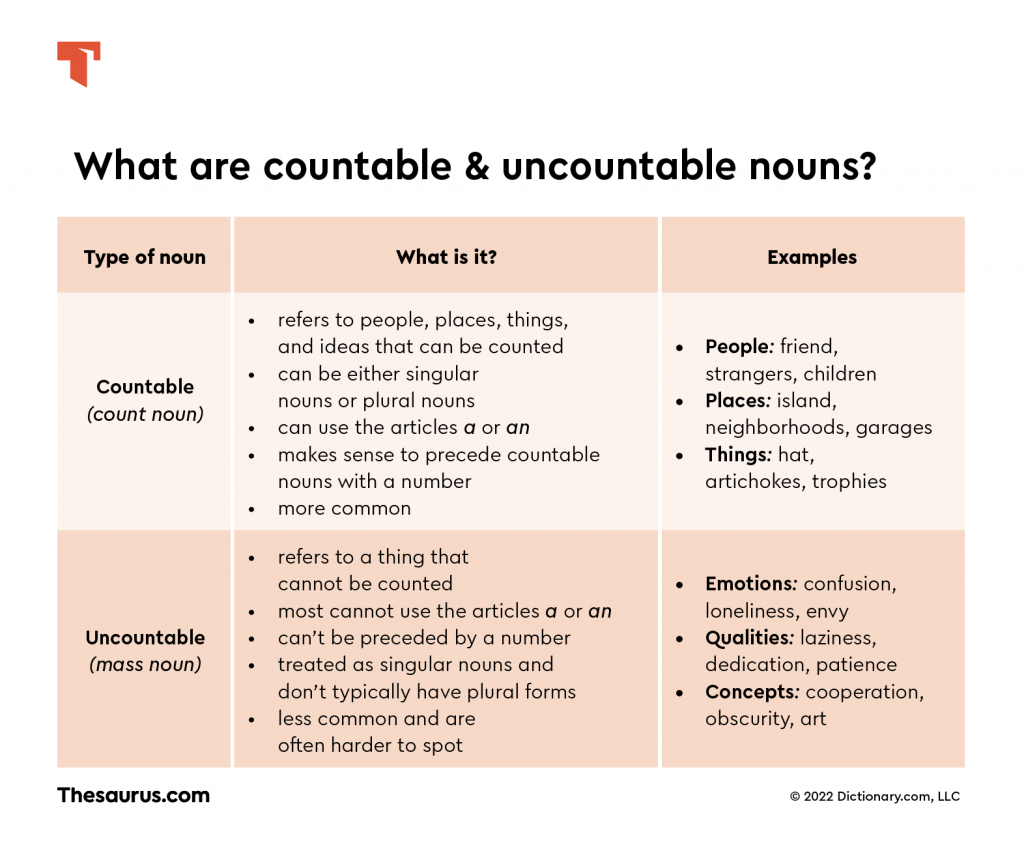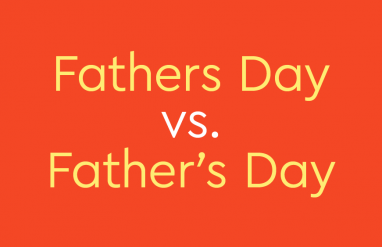Here is a fun challenge: Let’s count some of the things you see around you. Count how many chairs are in the room you are in or how many clouds are in the sky if you are outside. Now, count how much happiness you have—one happiness, two happinesses, 987 happinesses?! Did our little challenge suddenly become a lot more difficult? If you know your grammar, you probably know that the words chairs, clouds, and happiness are all nouns, words that refer to people, places, things, and ideas. Our not-much-fun challenge has shown the difference between two particular types of nouns that we use. These are countable nouns and uncountable nouns.
Countable noun vs. uncountable noun
A countable noun, or count noun, is “a noun that typically refers to a countable thing and that in English can be used in both the singular and the plural and can be preceded by the indefinite article a or an or by a number.”
An uncountable noun, or mass noun, is “a noun that typically refers to an indefinitely divisible substance or an abstract notion, and that in English cannot be used, in such a sense, with the indefinite article or in the plural.”
Putting it simply, countable nouns refer to people, places, things, and ideas that you can count (1, 2, 3, 100, 987,00,000, etc.), and uncountable nouns refer to things you can’t. Let’s explore each of these types of nouns more thoroughly so you can get a better idea of how they are different.
Countable nouns
Of the two, countable nouns are more common and are relatively easier to understand. A simple way to tell if a noun is a countable noun is to ask yourself if the person or thing the noun is referring to can be counted. Most nouns that refer to people and places, for example, are countable nouns. Countable nouns can be either singular nouns or plural nouns. Countable nouns can use the articles a or an, and it makes sense to precede countable nouns with a number.
Examples of countable nouns
Many different nouns that refer to people, places, and things are countable nouns.
- People: friend, strangers, boy, girls, hunter, children, assistant, boss
- Places: island, town, countries, continent, neighborhoods, basement, garages
- Things: bags, hat, computer, books, vehicle, artichokes, wheel, trophies
Although it may seem strange at first glance, some abstract nouns can also be countable nouns. Ask yourself if it makes sense to put the articles a or an or a number in front of these nouns and you will see that these nouns can be countable nouns:
- idea, guesses, question, suggestion, alternatives, opportunities, dream, goals, problem
Uncountable nouns
Compared to countable nouns, uncountable nouns are less common and are often harder to spot. An uncountable noun refers to a thing that cannot be counted. Unlike countable nouns, most uncountable nouns cannot use the articles a or an or can’t be preceded by a number. In addition, most uncountable nouns are treated as singular nouns and they don’t typically have plural forms.
Examples of uncountable nouns
Most uncountable nouns are abstract nouns that refer to things such as emotions, qualities, and concepts.
- Emotions: sadness, happiness, rage, anger, confusion, loneliness, envy
- Qualities: bravery, cruelty, kindness, agility, laziness, dedication, patience
- Concepts: cooperation, obscurity, art, entertainment, boredom, poverty, intelligence
Sometimes, concrete nouns can be uncountable nouns. Look at each of these words and think about if it makes any sense to put the articles a or an or a number in front of them:
- furniture, police, water, luggage, bread, baggage, air, milk, rain, snow, fog, smoke, wood, gold
Explore uncountable nouns even further in our useful article about them.
How do you use countable and uncountable nouns?
We have touched on it a little bit, but we use countable and uncountable nouns in different ways to make grammatically correct sentences.
As we’ve noted, countable nouns can typically use the articles a and an while uncountable nouns can’t. For example, it is correct to say I have a cat, but it is incorrect to say, “I bought a bread at the store.” (Instead, we’d say I bought a loaf of bread at the stores—two loaves, actually, because all this counting is making us hungry.)
Countable nouns can also follow a number while uncountable nouns cannot. You can say She owns three houses but it is wrong to say, “He feels two happinesses.” (Although some people may break grammatical rules for humorous effect.)
Countable nouns can be either singular or plural, which means they can use either singular or plural verbs as in The monkey eats bananas and My sisters are rich. Most uncountable nouns are singular nouns and use singular verbs as in Grammar is important.
Uncountable nouns often don’t have plural forms: for example, we generally don’t say our house is full of “furnitures” nor do we put “milks” in our coffee. Rather than use plural nouns, we often instead use the form “X of Y” to refer to different amounts of an uncountable noun. For example, we would say that we have three boxes of junk or a load of junk rather than incorrectly saying that we have “three junks” or “a junk.”
However, some uncountable nouns are plural and use plural verbs as in The police are at the crime scene or Those extra services were too expensive. Be careful of sneaky uncountable nouns like these!
The gray areas
Sometimes, a word can appear to be either a countable or uncountable noun depending on how it is used. For example, a person may say they want “two waters” or that they need “three ketchups” when they actually mean they want two bottles of water or three packets of ketchup.
This gray area is common when dealing with words with multiple meanings. Sometimes, a word can be either a countable noun or an uncountable noun depending on what exactly it is referring to. For example, the word iron can refer to an appliance used to get wrinkles out of clothes. In this case, iron is a countable noun because it makes sense to say We bought three irons at the store. However, the word iron can also refer to a chemical element. In this case, iron is now an uncountable noun because it doesn’t make sense to say that a molecule has “six irons.” It either contains iron or it doesn’t.
This is especially common when dealing with abstract nouns. For example, delight is an uncountable noun when referring to the happy emotion, but it is a countable noun when it refers to something or someone that causes happiness; It is grammatically correct to say The toy box was filled with many delights.
Tips for differentiating countable vs. uncountable nouns
It may seem obvious, but the biggest tip that will help you decide if a noun is a countable noun or an uncountable noun is to determine if whatever the noun is referring to can be counted or not. If it can, it is a countable noun. If it can’t, it is an uncountable noun. You can count beans, so beans is a countable noun. You can’t count greed, so greed is an uncountable noun.
Countable and uncountable nouns and fewer vs. less
Countable nouns lead us to the heated fewer vs. less debate. In general, we use fewer with countable nouns as in I need to buy fewer apples next time and less with uncountable nouns as in I think the puppy did better with less discipline. However, there are many exceptions to this general rule, such as when referring to distances as in The store is less than three miles away.
The words less and fewer are used interchangeably more and more often in everyday speech (no matter how grammar purists may feel about it—and they often feel very strongly about it).
Proper nouns issues
Up until now, we have only been focused on common nouns. But what about proper nouns? In general, we treat all proper nouns as if they are uncountable nouns. Proper nouns almost always follow the rules of uncountable nouns in that it doesn’t make sense to precede them with a, an, or a number. We don’t buy cars made by “a Toyota” and we don’t speak “six Germans.”
However, it is accurate to say that England has had six King Georges. Is the plural noun King Georges a countable noun in this sentence? We cannot solve this debate right now, but the important thing to keep in mind is that some people may argue that proper nouns can be considered countable nouns.
Finally, let’s put everything you have learned about countable and uncountable nouns to the test. Each of the following sentences has one example of a countable and uncountable noun. Can you tell which is which?
- Dolphins are known for their intelligence.
- I need to get more oil for my car.
- The tiny house was made of gingerbread.
- There is a baseball sitting in the grass.
- My daughters love to play baseball.
- I really like grammar, but I still need to learn about nouns.
Sneaky nouns, be gone!
You can count on Thesaurus.com’s Grammar Coach™. This writing tool uses machine learning technology uniquely designed to catch grammar and spelling errors. Its Synonym Swap will find the best nouns, adjectives, and more to help say what you really mean, guiding you toward clearer, stronger, writing.
Are you ready for the official quiz on countable vs. uncountable nouns now? Take it here!
Answers: 1. Countable; uncountable 2. Uncountable; countable 3. Countable; uncountable 4. Countable; uncountable 5. Countable; uncountable 6. Uncountable; countable
















